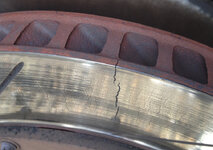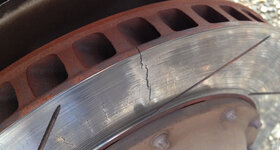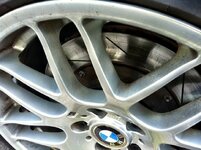I have a BMW Z4M that I equipped with a full AP racing BBK in 2011. I bought this set brand new with my local AP dealer for street driving and doing some occasional trackdays (mostly Nurburgring). With my first set of front AP discs I did two years of street and track day driving and never had a big problem, then they were worn down and it was time to replace them.
9-10 months a go my Belgian AP dealer fitted new front AP discs on my car. With the new AP discs (CP-3581 / G8) I only did 3-4 tourist trips to the Nurburgring and 1 trip to Spa. The car is not used on track from november till march...so the new discs did not see a lot of hard use. Before stopping the car; I always do a cool down run without breaking, to let the brakes cool before parking the car. My car is also equipped with some extra brake cooling ducts for extra air.
After my last trackday my right front AP discs looked liked this.


This is not normal and it's unsafe to still use this disc! I'm always using the same brake pads and using the same brake method as in the past. Never had any problems before with my previous set of AP discs! The crack on the edge made 1 disc useless...while the front disc are only 20-30% worn down and are still in really good shape (besides the damage).
In my opinion this is not normal for a high quality AP discs, that costs this much money. In my opinion I had bad luck and I received a faulty manufactured AP brake disc (this can happen). I hope AP can help me fix this issue and give me a solution.
Me and my other trackday buddies are all using AP racing on our track day cars and we love them... Trackday enthusiast talk a lot about their modifications and their experiences online. We are hoping AP can give an explanation on how this happened and a goodwill solution from AP to fix this problem. It's absurd to already have to buy a new set of two AP discs again so soon. If AP racing does not want to replace the discs, then I will not take the gamble with AP again and I will buy a set Performance Friction front discs (they promise no cracking).
Any opinions about Performance Friction discs vs AP racing discs? They fit perfectly on the AP racing bell and have identical size..
9-10 months a go my Belgian AP dealer fitted new front AP discs on my car. With the new AP discs (CP-3581 / G8) I only did 3-4 tourist trips to the Nurburgring and 1 trip to Spa. The car is not used on track from november till march...so the new discs did not see a lot of hard use. Before stopping the car; I always do a cool down run without breaking, to let the brakes cool before parking the car. My car is also equipped with some extra brake cooling ducts for extra air.
After my last trackday my right front AP discs looked liked this.


This is not normal and it's unsafe to still use this disc! I'm always using the same brake pads and using the same brake method as in the past. Never had any problems before with my previous set of AP discs! The crack on the edge made 1 disc useless...while the front disc are only 20-30% worn down and are still in really good shape (besides the damage).
In my opinion this is not normal for a high quality AP discs, that costs this much money. In my opinion I had bad luck and I received a faulty manufactured AP brake disc (this can happen). I hope AP can help me fix this issue and give me a solution.
Me and my other trackday buddies are all using AP racing on our track day cars and we love them... Trackday enthusiast talk a lot about their modifications and their experiences online. We are hoping AP can give an explanation on how this happened and a goodwill solution from AP to fix this problem. It's absurd to already have to buy a new set of two AP discs again so soon. If AP racing does not want to replace the discs, then I will not take the gamble with AP again and I will buy a set Performance Friction front discs (they promise no cracking).
Any opinions about Performance Friction discs vs AP racing discs? They fit perfectly on the AP racing bell and have identical size..
